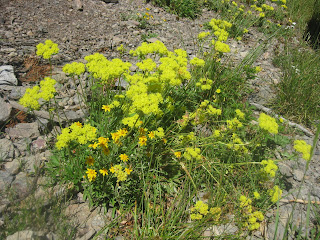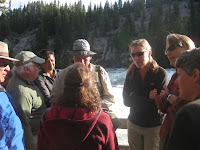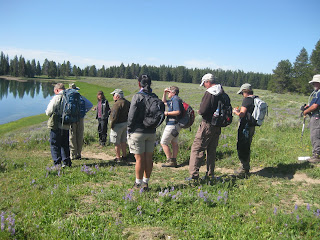We started out early at 7:30 again. The first stop was the LeHardy Rapids. This is a major spawning route for the cutthroat trout. This is the "hinge line" of the deformation of the caldera. The Sour Creek dome is across the river with an exposed potion of the Lava Creek cut at the bottom.
We then headed up to Hayden Valley, the "Serengeti of the Yellowstone." The diversity in the area is very unusual for being inside the caldera (rhyolite is nutrient poor so it doesn't usually support a lot of vegetation.)

Next stop: Artist Point.You can see the different types of sediments on top of the lava flows. At the very top of the clifss are kames. All of these are representative of a single flow event. The vertical joints in the lava flow are caused by cooling.
Coming out of Canyon out of Dunraven: the best way to tell when you leave the caldera is when the vegetation changes. We stopped at the first pullout on the way up to Mount Washburn. From there, you can look south to Mount Sheridan. There are lava flows evidenced by steep sides, bulbous fronts and flat, hummocky tops. Pitchstone Plateau is one of the largest examples of this in the park.
We then took the Road to Norris. We stopped at Nymph Lake. Across the road is Lava Creek. Looking toward the lake, there is a new thermal feature. It showed up in 2003. It looks like a small burnout that is moving in a North/South direction.
We then started up the Monument Geyser trail. It's a trail that climbs 1,000 feet in a mile. It's short but steep. The high side of the road is rhyolitic lava flow and according to Lisa, "We're on a big fissure here." The ph's in this area vary from about .2-4. At the top, it's an acid-sulfate system, but Beryl Springs at the bottom is a neutral chloride system and about 6.5 ph. The spires up here were created under water. Lisa is supposing that these particular spires may have even been formed underneath Yellowstone Lake (aka, it extended all the way up to Monument.) The spires on Monument are about 16-24 thousand years old. Th spires in the Lake have been uranium-dated to 11,000 years old.
After a fairly heavy rainfall on our way back down, we headed off to the Madison Junction. It was
The Yellowstone caldera isn't going to erupt again, there isn't enough magma left in the chamber. However, there could be another caldera-forming eruption somewhere else in the
park.


























